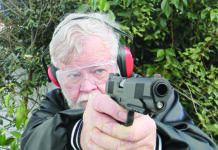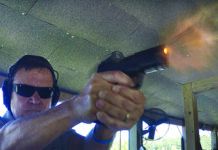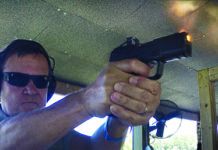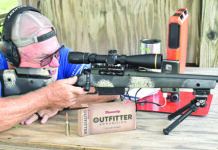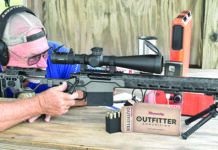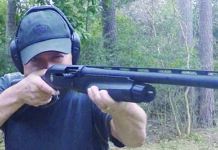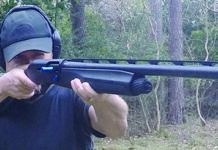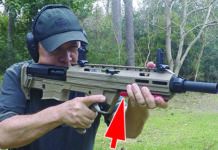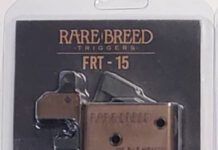Introduced in 1990, the .40 S&W cartridge was developed primarily for the police community. It combines a 40-caliber bullet with a high operating pressure (35,000 psi) for maximum stopping power. Like the .357 Magnum, a high-pressure revolver cartridge we tested two years ago, most of the ammunition we tried in this evaluation performed just as it is supposed to. Only one load needs to be avoided.
To test the effectiveness of the different brands, we bought twelve different self-defense loads. For a direct comparison, all were as close as possible to 155 grains in bullet weight. None were advertised to penetrate Kevlar body armor. None were limited to law enforcement personnel. All the shooting was done with a Star pistol with a 3 1/2-inch barrel.
How We Rated
We based our rating on the muzzle energy and the expansion ratio. To be effective a bullet must transfer its kinetic energy to the target. And, it must transfer that energy into the target, not onto the outer surface. Thus, an effective bullet must start out with a good measure of kinetic energy. We calculated the muzzle energy of our test bullets from their actual measured weight and chronographed muzzle velocities.
However, energy alone won’t do the job. In our test of 9mm ammunition (June 1995), we compared a .44 Magnum Winchester 240-grain soft point load to a 9mm Cor-Bon 115-grain JHP. The little bullet gouged a cavity sixteen times larger than its big competitor. The big soft point didn’t expand enough, even though it ended up bigger than the little bullet and had nearly twice its kinetic energy. There’s no such thing as a bullet that’s so big it doesn’t need to expand. An effective bullet needs to expand in the target and exit a lot slower than it went in, if it exits at all. This is the reason we consider expansion in our ratings.
We didn’t consider the size of the cavity in the gelatin, although it’s normally a good measure of bullet effectiveness all by itself. The ballistic gelatin provided an excellent impact medium for the bullets.
The Results
The condensed results of our tests are listed in the Summary Table. Below are our comments and observations listed in descending order of performance. There was very little difference between any of the solid core bullets rated as excellent.
Cor-Bon 150-grain JHP. This load was a little lighter, but not, as you would expect, a little faster than some of the other excellent loads. In fact, it was about 100 feet per second slower than the label on the box, which means it had only 85 percent of the energy it should have had. Nevertheless, this was still a very effective well-balanced load. On the second shot through the gelatin cylinder, this load didn’t enter the water column. Instead, it bounced off the neoprene diaphragm. There just wasn’t much energy left in the bullet after it exited the gelatin. Our Rating: Best of Test.
PMC Starfire 155-grain JHP. An all-around well-balanced load. If you carry your spare ammunition in a leather pouch, this should be your first choice because the cases were nickel-plated and won’t corrode with green crud. Our Rating: Excellent.
Winchester Silvertip 155-grain JHP. Another all-around effective, well-balanced load with no measurable weaknesses. Our Rating: Excellent.
Federal Hydra-Shok 155-grain JHP. This bullet didn’t need a lot of speed to fully expand. It was easily the lowest velocity expander in the test. A little lead pin in the center of the hollow point stayed erect while the edges folded back in a big mushroom. If you need a load with minimum recoil and maximum expansion, try this one. It had a nickel-plated case that won’t corrode in a leather pouch. Our Rating: Excellent.
Hornady XTP 155-grain JHP. The XTP stands for Extreme Terminal Performance and that’s a good description of this round. It had the highest velocity and energy of the solid core ammunition, as well as good expansion and a large cavity. Accuracy was poorer than the other excellent loads, but this will vary from gun to gun. Our Rating: Excellent.
Note: The last four of the above solid core, excellent loads did not fare so well last year when we tested .45 ACP ammunition (August, 1997). PMC Starfire failed to expand at all, while Hornady XTP failed some of the time. Both Federal Hydra-Shok and Winchester Silvertip were rated mediocre. The 9mm Starfire was also rated unsatisfactory (June, 1995).
Glaser 115-grain Blue Tip. This load’s bullet consisted of a load of No. 12 shot contained in a metal jacket. It was the hottest round of the test at 456 foot-pounds of energy, and the only one to expend all its energy in the gelatin block—nothing exited. But, we felt it was an indoor round. It won’t penetrate as many walls as a solid bullet if you miss your intended target, and it probably won’t go all the way through your target. It was also a close range round, due to its poor accuracy. Our Rating: The preferred night-stand load.
Winchester SXT 165-grain JHP. This load was the successor to the notorious Black Talon, and it was better than the Black Talon. We tested a left-over .45 ACP Black Talon last year and it didn’t expand with the hollow point plugged. This load did. It was nickel-plated too. Otherwise, it was a standard defense load. Our Rating: Good.
Speer Gold Dot and CCI Blazer 155-grain JHPs. These are two similar loads sharing a fine handgun bullet, Speer’s Gold Dot. It was a bonded bullet. The lead core was bonded to the jacket with a process similar to soldering. Note how the lead of the core adhered to the leaves of the jacket as they folded back to expand. This was one bullet that shouldn’t shed its jacket under any circumstances.
Except for this bullet, only the finest and most expensive (as much as $2.50 each) rifle bullets are bonded. The Gold Dot name refers to a short plug of jacket-metal that projects up from the concave base of the bullet into the lead core. When full expansion occurs, the tip of the pin is exposed showing a jacket-metal dot in the center of the mushroom.
But, neither of these loads were classified as excellent. Both were just a little too slow to pass our demanding test of an excellent load. (The bullet must fully expand in ballistic gelatin with its hollow point plugged with clay. The clay plug duplicates the worst possible condition of clothing plugging the hollow point.) Both bullets did fully expand, and showed their gold dots, when the hollow points were unplugged. With the hollow points plugged, both opened enough to cut a medium-sized cavity. Under practical conditions, these bullets would have good stopping power, even if they didn’t fully expand. Any combination of dry clothing shouldn’t inhibit their expansion.
The CCI Blazer has an unusual case—it’s made of aluminum. The primer is also unusual—it’s a Berdan primer, which is difficult to remove from the case. These cases aren’t suitable for reloading, but they’re inexpensive. If the cost of your defensive ammunition is important to you, this is your choice. Our Rating for both: Good.
Remington 155-grain JHP. A standard defense load with no serious faults. Our Rating: Good.
Remington Golden Saber 165-grain JHP. This ammunition’s bullet had a brass jacket and its case was nickel plated. Otherwise, it was a standard defense load. Our Rating: Good.
Federal Classic 155-grain JHP. This bullet didn’t expand at all with the hollow point plugged, but the upper half of the jacket was torn loose. We couldn’t believe it performed this badly. Two more shots produced the same results. It did expand a little with the hollow point open, but yielded the weakest expansion of the entire test. Our Rating: Unsatisfactory.
Note: Two years ago (September, 1996) we tested .357 Magnum defensive ammunition and the Federal Classic (with a Hydra-Shok bullet) was rated as excellent.
In this caliber, that same brand of ammunition (but with a different bullet) was unsatisfactory. The same thing was more or less true with four of the excellent solid core loads in this test (except Cor-Bon). They all rated much lower last year in .45 ACP. This raised the question of whether the wide swings in performance were from caliber-to-caliber or from year-to-year, or both. In either case, you may want to test the ammunition you have on hand before relying on it.
If you’re one of those people who buy their ammunition by brand name rather than test results, or forget which load tested excellent, our chief tester has just one word of advice for you—Cor-Bon.
Bottom Line
We highly recommend buying any of the .40 S&W ammunition rated as excellent. The loads rated as good were pretty good, too.
How We Tested
We tested for accuracy by shooting a five-shot group at 50 feet using a Case-Gard plastic rest. The results are shown in the Summary Table. All twelve loads were more than accurate enough for their intended use. (Remember that different guns will shoot the same ammunition with different results.) We tested bullet terminal performance by shooting at least two shots of every load into a cylinder of ballistic gelatin and catching the exiting bullet in our water trap.
Our expansion medium was Kind and Knox Ordnance Gelatin. It was formulated to resemble mammal flesh and blood as closely as possible and was completely uniform throughout. Every bullet encountered exactly the same expansion medium, allowing relative performance to be fairly judged. It also provided a means to judge actual performance. The wound channel or cavity that the bullet left in the gelatin could be readily seen and photographed.
We mixed the gelatin according to instructions from Kind and Knox—10 percent by weight. It was cast into 9-inch by 9-inch cylinders. This size was chosen to duplicate an intended target. When firm, the cylinder was set, on end, about a foot in front of our water trap and a shot was fired through it on a diameter line. All but the fragmented (Glaser) bullet completely penetrated the gelatin and were caught by the water trap. A block of ballistic gelatin can be seen to bulge and return back to normal as a bullet passes through it. The bullet creates a cavity on the way through, but it promptly collapses, thus it can’t be measured. However, the disturbed gelatin can be seen and photographed.
We had the best luck using back lighting, actually bottom lighting, when photographing the cavities. The cylinder was placed on a clear sheet of plastic with a white sunlit surface two feet below it. A black mask with a 9-inch round hole was fitted over the cylinder and a black cardboard tube was placed over the mask. The photographs were taken through the tube with the only light coming through the gelatin. Since only the undisturbed gelatin transmits very much light, the cavity appears dark.
The cavity we photographed is called the temporary cavity because it promptly collapses. Some writers refer to a permanent cavity. This is defined as the product of the cross section area of the expanded bullet times the length of the bullet hole. It’s a mathematical concept, not a cavity in gelatin. The gelatin recloses around the entire bullet hole.
Before firing the bullets into the gelatin, we plugged the hollow points with modeling clay to simulate the effect clothing might have on expansion. The clay was more effective in stopping expansion than bits of cloth. It created a worst-case condition. You can depend on a bullet that expanded with a clay plug in the hollow point to expand no matter what kind of clothing it encounters.
Our water trap is an aluminum trough 14 inches by 14 inches and 54 inches long. The front end is closed with a neoprene diaphragm. When the diaphragm gets so full of holes (about ten) that the waters runs out faster than we can refill, the diaphragm is replaced. This trap allows us to catch a bullet after it exits the gelatin without further distortion. We can measure the expansion and photograph the bullet. The expansion of every bullet in the test is reported in the Summary Table [PDFCAP(1)].
We also measured and reported how far each bullet penetrated the water column of our water trap after it left the gelatin. This can be a deceptive measurement. Bullets penetrate the water easier than the gelatin.
Velocities were measured with an Oehler Model 35 chronograph. Two of the loads, Cor-Bon and Hornady, had their velocities printed on the box. In both cases, actual velocities were slower than the manufacturer stated. The measured velocities were not used directly in the ratings, but were used to calculate muzzle energy.



